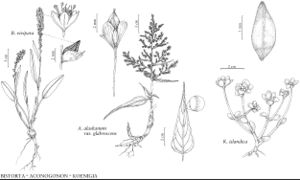Difference between revisions of "Bistorta vivipara"
Fl. Auvergne ed. 2, 2: 516. 1800.
FNA>Volume Importer |
imported>Volume Importer |
||
| (5 intermediate revisions by 2 users not shown) | |||
| Line 8: | Line 8: | ||
}} | }} | ||
|common_names=Alpine bistort | |common_names=Alpine bistort | ||
| − | |basionyms={{Treatment/ID/ | + | |special_status={{Treatment/ID/Special_status |
| + | |code=F | ||
| + | |label=Illustrated | ||
| + | }} | ||
| + | |basionyms={{Treatment/ID/Basionym | ||
|name=Polygonum viviparum | |name=Polygonum viviparum | ||
|authority=Linnaeus | |authority=Linnaeus | ||
| + | |rank=species | ||
| + | |publication_title=Sp. Pl. | ||
| + | |publication_place=1: 360. 1753 | ||
}} | }} | ||
|synonyms={{Treatment/ID/Synonym | |synonyms={{Treatment/ID/Synonym | ||
|name=Bistorta vivipara subsp. macounii | |name=Bistorta vivipara subsp. macounii | ||
|authority=(Small ex J. M. Macoun) Soják | |authority=(Small ex J. M. Macoun) Soják | ||
| + | |rank=subspecies | ||
}} {{Treatment/ID/Synonym | }} {{Treatment/ID/Synonym | ||
|name=Persicaria vivipara | |name=Persicaria vivipara | ||
| − | |authority= | + | |authority= |
| + | |rank=species | ||
}} {{Treatment/ID/Synonym | }} {{Treatment/ID/Synonym | ||
|name=Polygonum viviparum var. macounii | |name=Polygonum viviparum var. macounii | ||
|authority=(Small ex J. M. Macoun) Hultén | |authority=(Small ex J. M. Macoun) Hultén | ||
| + | |rank=variety | ||
}} | }} | ||
|hierarchy=Polygonaceae;Polygonaceae subfam. Polygonoideae;Bistorta;Bistorta vivipara | |hierarchy=Polygonaceae;Polygonaceae subfam. Polygonoideae;Bistorta;Bistorta vivipara | ||
| Line 46: | Line 56: | ||
-->{{#Taxon: | -->{{#Taxon: | ||
name=Bistorta vivipara | name=Bistorta vivipara | ||
| − | |||
|authority=(Linnaeus) Delarbre | |authority=(Linnaeus) Delarbre | ||
|rank=species | |rank=species | ||
| Line 60: | Line 69: | ||
|publication title=Fl. Auvergne ed. | |publication title=Fl. Auvergne ed. | ||
|publication year=1800 | |publication year=1800 | ||
| − | |special status= | + | |special status=Illustrated |
| − | |source xml=https:// | + | |source xml=https://bitbucket.org/aafc-mbb/fna-data-curation/src/2e0870ddd59836b60bcf96646a41e87ea5a5943a/coarse_grained_fna_xml/V5/V5_1210.xml |
|subfamily=Polygonaceae subfam. Polygonoideae | |subfamily=Polygonaceae subfam. Polygonoideae | ||
|genus=Bistorta | |genus=Bistorta | ||
Latest revision as of 22:08, 5 November 2020
Plants (2–)8–30(–45) cm; rhizomes sometimes contorted. Stems 1–2(–3). Leaves: ocrea brown, cylindric, 4–22(–27) mm, margins strongly oblique, glabrous; petiole attached to sheath 6–20(–45) mm, unwinged distally, 5–110(–200) mm; blade linear to lanceolate or oblong-ovate, 1–8(–10) × 0.5–1.7(–2.3) cm, base cuneate to rounded or cordate, often asymmetric, margins entire, usually revolute, not wavy, apex obtuse to acute, abaxial face pubescent with whitish or brownish hairs, glaucous, adaxial face glabrous, not glaucous; cauline leaves 2–4, petiolate proximally, sessile distally, gradually reduced distally, blade linear-lanceolate to linear. Inflorescences 1, narrowly elongate-cylindric, (15–)20–90 × 4–10 mm, usually bearing pink to brown or purple pyriform bulblets proximally and sterile flowers distally; peduncle 1–5 cm. Pedicels ascending or spreading, (1–)2–5 mm. Flowers 1–2 per ocreate fascicle; perianth greenish proximally, usually white or pink distally, rarely red; tepals obovate, 2.1–4 mm, apex obtuse to acute; stamens included or exserted, some or all often poorly developed; anthers reddish to purple. Achenes rarely produced, dark brown, 2.2–3.3 × 0.9–1.5 mm, dull, granular. 2n = 96, 120.
Phenology: Flowering Jun–Sep.
Habitat: Moist to wet spruce or mixed woods along shorelines, moist subalpine woods and meadows, alpine meadows, heaths, nutrient-rich sites
Elevation: 0-4000 m
Distribution

Greenland, St. Pierre and Miquelon, Alta., B.C., Man., N.B., Nfld. and Labr. (Labr.), N.W.T., Nunavut, Ont., Que., Sask., Yukon, Alaska, Ariz., Colo., Idaho, Maine, Mich., Minn., Mont., Nev., N.H., N.Mex., Oreg., S.Dak., Utah, Vt., Wash., Wyo., Europe, Asia.
Discussion
Bistorta vivipara is highly variable morphologically and cytologically. Robust plants with large leaves, compact spikes, and persistent bulblets have been named subsp. macounii. Abortion of stamens, production of bulblets, and the rarity of fruits suggest that reproduction is largely asexual; fruits and seedlings are produced rarely (N. Söyrinki 1989). B. Jonsell and T. Karlsson (2000+, vol. 1) summarized chromosome numbers that include 2n = 66, ca. 77, ca. 80, 88, 99, ca. 100, 110, 120, and ca. 132.
A. E. Porsild and W. J. Cody (1980) reported that indigenous peoples of the circumpolar region eat the starchy, slightly astringent rootstocks raw or cooked, and preserve them in seal oil or by freezing. E. Hultén (1968) reported that the rootstocks taste like almonds.
Selected References
None.
